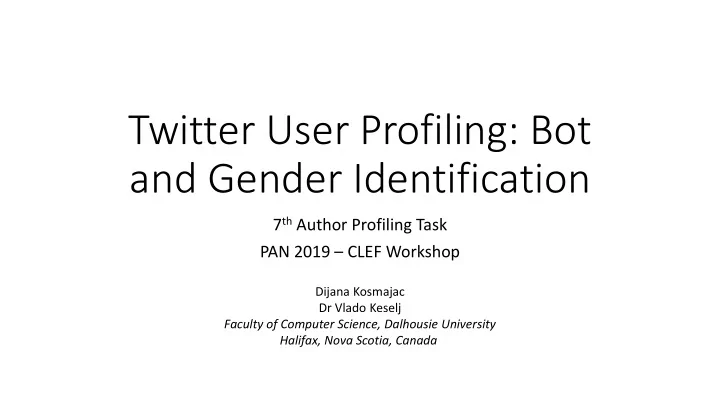

Twitter User Profiling: Bot and Gender Identification 7 th Author Profiling Task PAN 2019 – CLEF Workshop Dijana Kosmajac Dr Vlado Keselj Faculty of Computer Science, Dalhousie University Halifax, Nova Scotia, Canada
Overview • Introduction • Bot Detection on Social Media • Methodology • DNA-inspired User Behaviour Fingerprint • Diversity Measures • Dataset of 7 th Author Profiling Task • Experiments and Results • Conclusion Note: for gender detection approach, please refer to the working notes 2
Bot Detection on Social Media • Social media - convenient platforms for people to share, communicate, and collaborate. • Openness of social media is great, but… malicious behaviors happen, such as bullying, terrorist attack planning, and fraud information dissemination, etc. • Important task: detect these abnormal activities as accurately and early as possible to prevent disasters and attacks. • For this study we approached to a subdomain: bot detection Introduction Methodology Dataset Experiments Conclusion 3
Bot and Gender Detection on Social Media • DeBot: Twitter Bot Detection via Warped Correlation, Chavoshi et al., 2016 • DNA-Inspired Online Behavioral Modeling and Its Application to Spambot Detection, Cresci et al., 2016 Introduction Methodology Dataset Experiments Conclusion 4
DNA-inspired User Behaviour Fingerprint • Introduced first time in Cresci et al., 2016 User timeline 3 ∗ 2^3= 24 different labels ACBCADDCCAF… ASCII(65+ code ) Introduction Methodology Dataset Experiments Conclusion 5
DNA-inspired User Behaviour Fingerprint • We used 1-, 2-, 3- and 4-grams • 3-gram example: Introduction Methodology Dataset Experiments Conclusion 6
Diversity Measures 2 1 𝑛 𝑛𝑏𝑦 𝑊(𝑛, 𝑂) 𝑛 • Yule’s 𝐿 = 𝐷 − 𝑂 + σ 𝑛=1 𝑂 𝑊(𝑂) 𝑞 𝑗 ln(𝑞 𝑗 ) • Shannon’s 𝐼 = − σ 𝑗=1 1 • Simpson’s 𝐸 = 𝑊(𝑂) 𝑞 𝑗 2 σ 𝑗=1 log(𝑂) • Honore’s 𝑆 = 100 1− 𝑊(1,𝑂) 𝑊(𝑂) 𝑊(2,𝑂) • Sichel’s 𝑇 = 𝑂 Introduction Methodology Dataset Experiments Conclusion 7
Dataset • Bot t-SNE visualization. (a) English, (b) Spanish • English: • 2,880 train and 1,240 dev • Spanish: • 2,080 train and 920 dev Introduction Methodology Dataset Experiments Conclusion 8
Dataset • Diversity measures visualization for English Honore’s R Yule’s K Shannon’s H Simpson’s D Sichel’s S Introduction Methodology Dataset Experiments Conclusion 9
Dataset • Diversity measures visualization for Spanish Honore’s R Yule’s K Shannon’s H Simpson’s D Sichel’s S Introduction Methodology Dataset Experiments Conclusion 10
Experiments with language-specific training • Experiment 1: character n-grams range 2-4, w/o diversity measures. • Experiment 2: character n-grams 1-3, w/ diversity measures Introduction Methodology Dataset Experiments Conclusion 11
Experiments with combined training • Experiment 3: same as E1, only combined training set • Experiment 4: same as E2, only combined training set Introduction Methodology Dataset Experiments Conclusion 12
Official results • 13 th place in total, better than all baselines. Introduction Methodology Dataset Experiments Conclusion 13
Conclusion and Future Work • A novel, yet simple method for bot detection on social media. • Language independent, since it does not use the language-specific features. • Disadvantage – doesn’t consider language -specific features which may be more fine-grained. • Explore the effect of the length of the user fingerprint on ability to differentiate bot and genuine users. • Explore the effect of the timespan the fingerprint is collected. • Explore the effect of using variable length fingerprint. • Explore possibility of unsupervised bot detection using diversity measures and clustering. Introduction Methodology Dataset Experiments Conclusion 14
Recommend
More recommend